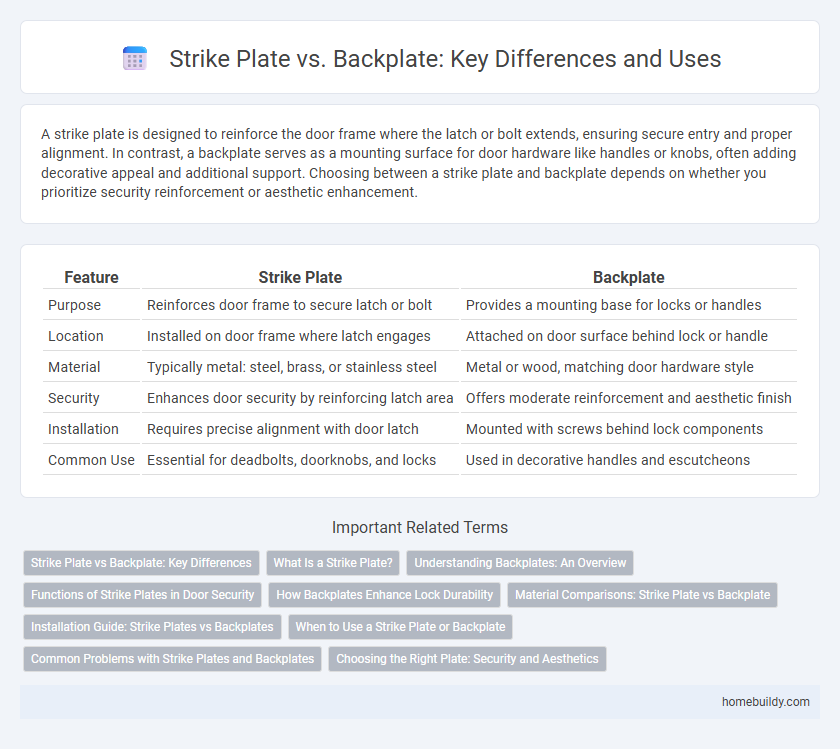A strike plate is designed to reinforce the door frame where the latch or bolt extends, ensuring secure entry and proper alignment. In contrast, a backplate serves as a mounting surface for door hardware like handles or knobs, often adding decorative appeal and additional support. Choosing between a strike plate and backplate depends on whether you prioritize security reinforcement or aesthetic enhancement.
Table of Comparison
| Feature | Strike Plate | Backplate |
|---|---|---|
| Purpose | Reinforces door frame to secure latch or bolt | Provides a mounting base for locks or handles |
| Location | Installed on door frame where latch engages | Attached on door surface behind lock or handle |
| Material | Typically metal: steel, brass, or stainless steel | Metal or wood, matching door hardware style |
| Security | Enhances door security by reinforcing latch area | Offers moderate reinforcement and aesthetic finish |
| Installation | Requires precise alignment with door latch | Mounted with screws behind lock components |
| Common Use | Essential for deadbolts, doorknobs, and locks | Used in decorative handles and escutcheons |
Strike Plate vs Backplate: Key Differences
Strike plates and backplates serve distinct functions in door hardware; the strike plate is mounted on the door frame to receive the latch or bolt, ensuring secure locking, while the backplate attaches to the door itself, often reinforcing the handle or lock mechanism. Strike plates are typically smaller, focusing on reinforcing the latch area to prevent forced entry, whereas backplates cover a larger area and may enhance both aesthetics and structural support. Choosing between them depends on security needs, door design, and whether reinforcement or decorative appeal is the priority.
What Is a Strike Plate?
A strike plate is a metal component installed on a door frame that reinforces the area where the latch or bolt extends to secure the door. It is designed to absorb the force from the latch, preventing wear and enhancing door security. Unlike a backplate, which is a decorative or protective plate surrounding the lock or handle on the door surface, the strike plate is specifically positioned on the frame for latching functionality.
Understanding Backplates: An Overview
Backplates serve as protective or decorative covers for door hardware, distributing force more evenly than strike plates alone. Unlike strike plates, which are installed on the door frame to receive the latch or bolt, backplates are mounted directly behind door handles or knobs, enhancing durability and aesthetic appeal. Choosing the right backplate improves door security and complements the overall hardware design.
Functions of Strike Plates in Door Security
Strike plates reinforce door frames by securing the latch or bolt in place, preventing forced entry and enhancing overall door security. Unlike backplates, which primarily protect the lock hardware and distribute impact, strike plates absorb and withstand physical impact at the point where the door closes. High-quality strike plates, often made of hardened steel and installed with long screws, significantly increase resistance to kick-ins and tampering.
How Backplates Enhance Lock Durability
Backplates significantly enhance lock durability by providing an additional layer of metal reinforcement around the lock mechanism, reducing wear and tear over time. Unlike standard strike plates that only secure the latch bolt, backplates distribute force more evenly, protecting the door surface and lock components from damage due to repeated use or forced entry attempts. This reinforcement minimizes the risk of misalignment and extends the overall lifespan of residential and commercial locking systems.
Material Comparisons: Strike Plate vs Backplate
Strike plates are typically made from hardened steel to withstand repeated impact and prevent wear from door latch movement, offering superior durability compared to backplates. Backplates often use softer metals or alloy blends primarily for decorative purposes, which may not provide the same level of security or resistance to force. Choosing a strike plate with robust material composition ensures enhanced protection and longevity for door locking mechanisms.
Installation Guide: Strike Plates vs Backplates
Strike plates and backplates differ significantly in installation complexity and purpose. Strike plates require precise alignment with the door latch or bolt, ensuring smooth operation and security, typically mounted on door frames with screws. Backplates serve as reinforcement on the door itself, often installed beneath handles or locks to protect against wear and enhance structural integrity, requiring accurate positioning to prevent hardware loosening.
When to Use a Strike Plate or Backplate
Use a strike plate when reinforcing the door frame to catch the latch or bolt, ensuring secure locking for standard doors and residential applications. Opt for a backplate when extra protection is needed for door handles or locks, particularly in commercial or high-traffic areas where enhanced durability against wear and tampering is critical. Strike plates are ideal for basic latch security, while backplates provide comprehensive reinforcement for both hardware and locking mechanisms.
Common Problems with Strike Plates and Backplates
Strike plates often experience misalignment, causing latch and lock malfunctions, while backplates may suffer from wear and corrosion that undermine door security. Improper installation of strike plates leads to repeated door sticking or difficulty in locking, whereas backplates can warp over time due to environmental exposure. Both components require precise fitting and durable materials to prevent common issues like loose screws, compromised door integrity, and reduced hardware lifespan.
Choosing the Right Plate: Security and Aesthetics
Strike plates are essential for reinforcing door frames and enhancing security by distributing the force of a closing latch or bolt. Unlike backplates, which primarily serve decorative purposes and protect door surfaces from wear, strike plates focus on durability and impact resistance, making them crucial for high-security applications. Selecting the right plate involves balancing material strength, corrosion resistance, and design compatibility to ensure both robust protection and aesthetic appeal.
strike plate vs backplate Infographic

 homebuildy.com
homebuildy.com